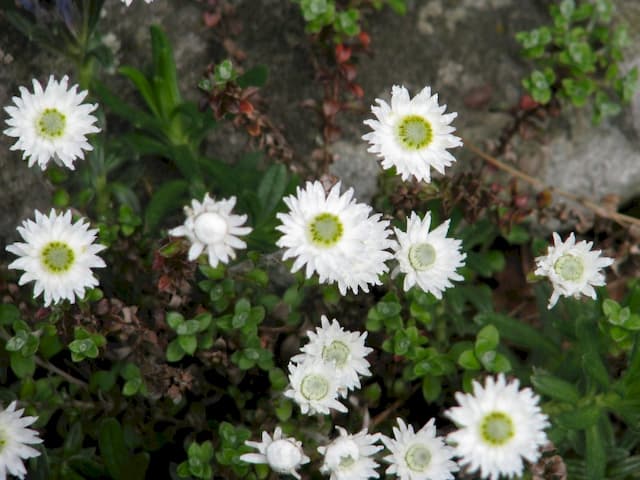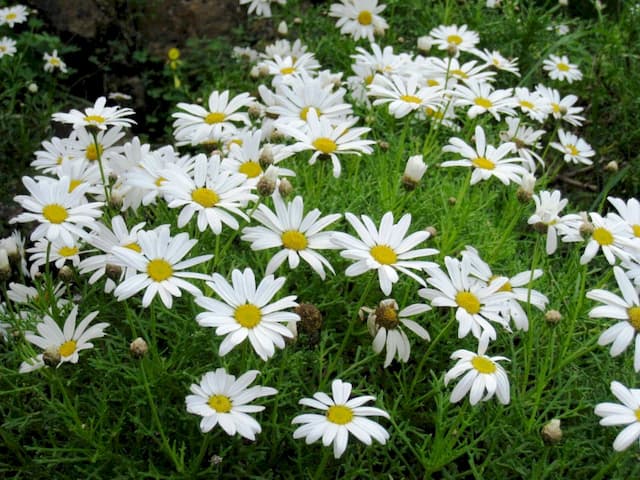Chrysanthemum Chrysanthemum 'Madeleine' (29c)

ABOUT
The Chrysanthemum 'Madeleine' boasts a delightful display of daisy-like flowers with a vibrant appearance. The blossoms are a cheerful hue, often showcasing a gradient of color that blends softly from the outer petals inward. The petals radiate around a central disk, which is typically a deeper, more intense shade, drawing the eye towards the heart of the flower. This pattern of colors creates a striking contrast and adds depth to the visual appeal of the blooms. The foliage of Chrysanthemum 'Madeleine' is rich and green, forming a lush backdrop for the flowers. The leaves are deeply lobed or divided, which adds to the textural interest of the plant. When in bloom, 'Madeleine' becomes a focal point in the garden due to its profusion of colorful flowers. The overall form of the plant is mounded, giving it a neat and tidy appearance that works well in garden borders, containers, or as part of a floral arrangement.
About this plant
 Names
NamesFamily
Asteraceae
Synonyms
Mums, Chrysanths, Garden Mums
Common names
Dendranthema 'Madeleine', Chrysanthemum morifolium 'Madeleine'.
 Toxicity
ToxicityTo humans
The plant commonly known as Chrysanthemum is not highly toxic to humans, but it can cause skin irritation in some individuals upon contact due to the presence of sesquiterpene lactones. If ingested, it can potentially cause mild gastrointestinal upset, including symptoms such as nausea, vomiting, and diarrhea.
To pets
Chrysanthemums are toxic to pets, including dogs, cats, and horses. If a pet ingests any part of the Chrysanthemum plant, they may exhibit symptoms such as vomiting, diarrhea, hypersalivation, incoordination, and dermatitis. In severe cases, ingestion can lead to more serious conditions, so it is advised to seek veterinary care if you suspect your pet has consumed this plant.
 Characteristics
CharacteristicsLife cycle
Perennials
Foliage type
Deciduous
Color of leaves
Green
Flower color
Varies
Height
1-3 feet (0.3-0.9 meters)
Spread
1-3 feet (0.3-0.9 meters)
Plant type
Herb
Hardiness zones
5
Native area
Asia
Benefits
 General Benefits
General Benefits- Ornamental Value: Chrysanthemum 'Madeleine' provides aesthetic appeal with its beautiful blooms, enhancing the beauty of gardens and landscapes.
- Long Blooming Period: It typically has a long flowering season, offering color and vibrancy for an extended period of time.
- Ease of Care: Known for being relatively easy to maintain, requiring standard gardening care such as watering, deadheading, and occasional fertilization.
- Variety of Uses: Suitable for borders, container gardening, and cut flowers, adding versatility to garden design and home decoration.
- Pollinator Attraction: Attracts bees, butterflies, and other beneficial pollinators, supporting local ecosystems and biodiversity.
 Medical Properties
Medical Properties- This plant is not used for medical purposes.
 Air-purifying Qualities
Air-purifying QualitiesThis plant is not specifically known for air purifying qualities.
 Other Uses
Other Uses- Natural dye: The petals of Chrysanthemum 'Madeleine' can be used to produce a natural yellow dye for fabrics and textiles.
- Insect repellent: The plant can be used in gardens or around the home to naturally repel insects due to its natural pyrethrin content.
- Aquarium water treatment: Dried Chrysanthemum petals can be used to manage the growth of certain algae and bacteria in aquariums.
- Companion planting: Chrysanthemum 'Madeleine' can be used in vegetable gardens to attract beneficial insects like ladybugs and to deter pests.
- Biological indicators: The health of Chrysanthemum plants can indicate the presence of environmental pollutants like ozone, making them useful bioindicators.
- Photography: The bright and vivid flowers are often used as subjects in macro photography and nature photography due to their intricate details.
- Culinary decoration: Though not commonly consumed, Chrysanthemum petals can be used to add a splash of color to salads and desserts.
- Book pressing: The flowers can be used in the traditional craft of flower pressing, which is then used to create decorative bookmarks or in scrapbooking.
- Eco printing: The leaves and flowers are used in the art of eco printing, where they leave natural prints on paper or fabric.
- Sustainable confetti: Dried petals of Chrysanthemum 'Madeleine' can be used as an eco-friendly confetti alternative at weddings and celebrations.
Interesting Facts
 Feng Shui
Feng ShuiThe Chrysanthemum is used in Feng Shui for bringing happiness and laughter to the home, symbolizing longevity and joy. Place it in the living area to promote good health and in the home office to sharpen focus.
 Zodiac Sign Compitability
Zodiac Sign CompitabilityThe Chrysanthemum is not used in astrology practice.
 Plant Symbolism
Plant Symbolism- Longevity and Immortality: Chrysanthemums are often associated with long life and immortality in many cultures due to their ability to bloom into the late autumn when other plants have faded.
- Happiness and Joy: Its vibrant and diverse range of colors signify happiness and positivity, making it a popular gift to uplift someone's spirit.
- Loyalty and Devotion: The Chrysanthemum is believed to symbolize deep passion and devotion, making it a common choice in bouquets meant to convey loyalty in friendships and romantic relationships.
- Rebirth and Renewal: The cycle of blooming year after year symbolizes the ideas of renewal and starting anew, akin to the rejuvenating quality of life.
- Nobility: In some Asian cultures, the Chrysanthemum, particularly those of certain colors like royal yellow or purple, is associated with nobility and elegance.
 Water
WaterMums require consistent moisture and should be watered deeply when the top inch of soil feels dry to the touch. This typically means providing water once or twice a week, depending on weather conditions. Apply water slowly at the base of the plant, avoiding wetting the foliage, as this can lead to disease. It's crucial to provide thorough watering each time, which may amount to around 1 gallon per plant, especially during peak summer heat. During the fall, watering can be reduced as the plant prepares for dormancy.
 Light
LightMums thrive in full sun conditions, meaning they prefer to receive at least 6 hours of direct sunlight each day. The best spot for a Chrysanthemum 'Madeleine' would be in a location where it can bask in the morning sun and be protected from the intense late afternoon sun. However, they can also tolerate partial shade, particularly in hotter climates where some relief from the afternoon sun can be beneficial.
 Temperature
TemperatureMums are relatively hardy and can tolerate a wide range of temperatures, but they grow best when daytime temperatures are between 60°F and 75°F. They can survive minimum temperatures down to 20°F, but a hard freeze can be detrimental to the plant. The ideal temperature range promotes robust growth and full blooms.
 Pruning
PruningPruning Chrysanthemum 'Madeleine' encourages a bushier growth habit and more abundant blooms. Pinch back the growing tips when the plants are about 6 inches tall and repeat every few weeks until mid-summer. Stop pruning by early August to allow flower buds to form. Prune off any spent blooms to promote further flowering and maintain plant health.
 Cleaning
CleaningAs needed
 Soil
SoilThe best soil mix for Chrysanthemums is well-draining with a mixture of peat, perlite, and compost. Aim for a soil pH between 6.0 and 7.0 for optimal growth.
 Repotting
RepottingChrysanthemums should generally be repotted every 1 to 2 years to ensure they have ample room to grow and to refresh the soil.
 Humidity & Misting
Humidity & MistingChrysanthemums prefer average room humidity levels around 40-60%. They don't require exceptionally high humidity to thrive.
 Suitable locations
Suitable locationsIndoor
Ensure bright light, well-draining soil, regular watering for indoor chrysanthemums.
Outdoor
Full sun to part shade, well-draining soil, regular watering for outdoor growth.
Hardiness zone
5-9 USDA
 Life cycle
Life cycleThe life of Chrysanthemum 'Madeleine' begins with seed germination, which takes place in a warm and humid environment after sowing. Upon sprouting, the seedling stage sees the growth of the first true leaves and establishment of the plant. Vegetative growth follows, where the plant develops a robust root system and numerous leaves, preparing for flowering. The flowering stage is entered under shorter days or cooler temperatures, with the plant producing distinctive, decorative blooms. After pollination, if it occurs, the plant may produce seeds, completing the sexual cycle, though many chrysanthemums are propagated vegetatively via cuttings. Finally, the plant enters dormancy during colder months or adverse conditions, only to resume growth with the return of favorable weather.
 Propogation
PropogationPropogation time
Spring-early summer
The common Chrysanthemum, known as 'Mums' or Hardy Chrysanthemum, particularly the 'Madeleine' cultivar, is typically propagated through division, which is the most popular method. To propagate Chrysanthemums 'Madeleine' by division, the process is done in early spring just as the new growth begins to appear. The plant is carefully dug up and the root ball is divided into smaller sections, ensuring that each section has at least one shoot and a portion of the root system. These sections are then replanted at the same depth they were growing originally, spaced about 18 to 24 inches (approximately 45 to 60 centimeters) apart to allow sufficient room for growth, and watered thoroughly to help establish the newly divided plants. This method of propagation is effective because it helps rejuvenate older clumps that might otherwise become too dense and promotes vigorous growth in the new planting locations.









